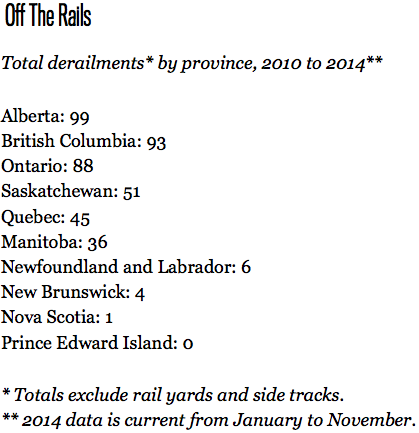Repost from Oregon Public Broadcasting
[Editor: Significant quote for us in California: “The trains originate in Alberta, moving through Idaho to Washington. From there, some are bound for refining in Western Washington and others travel along the Columbia River into Portland and south into California.” – RS]
Big Trainloads Of Tar Sands Crude Now Rolling Through NW
By Tony Schick, Feb. 9, 2015
Trains carrying mass loads of heavy crude oil from Canada’s tar sands have begun moving through the Northwest, creating the potential for an oil spill in parts of Oregon and Washington where environmental agencies have no response plans or equipment in place.
Union Pacific now moves between seven and 10 of these mile-long trains of Canadian crude per month through Northwest states, according to railroad spokesman Aaron Hunt. They can carry more than a million gallons of oil.
The trains originate in Alberta, moving through Idaho to Washington. From there, some are bound for refining in Western Washington and others travel along the Columbia River into Portland and south into California.
The seven to 10 monthly trains represents a big increase over Union Pacific trains that had previously been hauling mixed freight that included oil tank cars. The mile-long “unit trains” began in late November, according to the railroad, but spill planners at Oregon’s Department of Environmental Quality and Washington’s Department of Ecology didn’t learn of the new shipments until late January and early February, respectively.
Both agencies, along with emergency responders and rail safety inspectors, were previously caught unprepared in 2013 when shipments of sweet light crude from North Dakota’s Bakken oil fields started moving through the region.
Railroads are required to notify states about oil shipments larger than one million gallons under an emergency order from the federal Department of Transportation. The order was filed in response to national concerns about local fire departments being caught unaware or kept in the dark when these “rolling pipelines” were passing through their jurisdictions.
That order applies only to Bakken crude; shipments from Canada are exempt. Oregon Sens. Ron Wyden and Jeff Merkley have called on the federal DOT to expand its regulation to include all shipments, with the aim of avoiding a situation like mile-long trains of tar sands crude moving without knowledge from the agencies tasked with oil spill cleanup.
“It is unacceptable that volatile tar sands oil has been moving through our communities for months and yet Oregon officials only found out about it last week,” Wyden said in a statement released to OPB/EarthFix. “This apparent lack of communication with state officials responsible for Oregonians’ health and safety is exactly why I have been pushing for an iron-clad rule to ensure first-responders in our communities are notified about these oil trains.”
Officials in Oregon and Washington said they lack the resources and authority for adequate spill planning along rail corridors. Rail lines touch more than a hundred watersheds in Oregon and cross more than a thousand water bodies in Washington.
Unlike plans for marine transports and storage facilities, plans for who responds, how and with what equipment are lacking in Oregon and Washington when it comes to rivers and lakes.
“We will respond, but our response won’t be as effective as it would be with the facilities where we’ve reviewed their plans, we know what they contain,” said Bruce Gilles, emergency response program manager at Oregon’s DEQ.
Should a train full of tar sand oil spill today, response teams will be “going in somewhat blind,” and that means they won’t be able to work as quickly as they should, Gilles said.
“You’re going to lose time, and that time translates into increased environmental damage and costs to clean up,” he said. “That’s the bottom line.”
David Byers, response manager for Washington’s Department of Ecology, said the state has begun filling the regional gaps where it lacks response plans, but the effort will take years.
Byers said tar sands crude presents many cleanup challenges the state’s never handled before.
Bitumen is a hydrocarbon extracted from Alberta’s tar sands. It’s too thick to be transported like conventional crude. It’s either refined into a synthetic crude — making it more like conventional crude oil — or combined with additives that give it a more liquid consistency.
A heavy tar-like substance, bitumen can sink when it hits water. It’s also stickier, meaning it’s tougher to remove from wherever it spills. That’s what happened when a pipeline burst and spilled into the Kalamazoo River in Michigan. The cleanup cost exceeded $1 billion.
Frequent rain and fast-moving rivers in the Northwest mean a lot of sediment that oil can stick to, further complicating cleanup.
Byers and Gilles say they have no way of knowing what specific type of crude is in a given oil tanker car. Knowing that they’re dealing with a tar sand crude oil spill would dramatically influence their response.
“It’s much harder to clean up on the bottom of a river bed,” Byers said. “Or if it sinks in, for example, Puget Sound, it’s going to be more difficult to clean up, and even more challenging for us to even locate and detect where the oil has migrated to.”
It wouldn’t just be up to Oregon or Washington officials to handle spill-response duties if an oil train derailed in their state. Union Pacific has 30 hazardous materials responders across its 32,000 mile network and relies on private contractors for handling spill incidents.
“This team of experts directs training, preparation and response for any type of accident involving hazardous materials,” spokesman Aaron Hunt said in an email. “We move hazardous materials on behalf of our customers because it is our job.”





